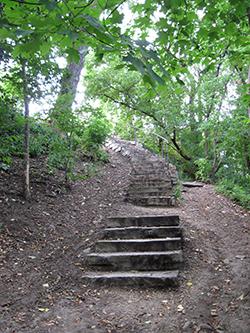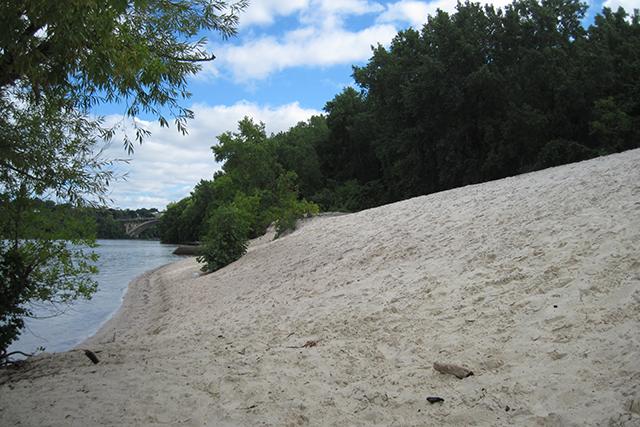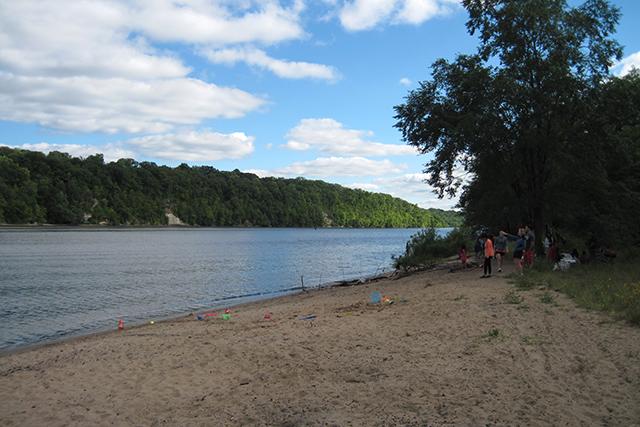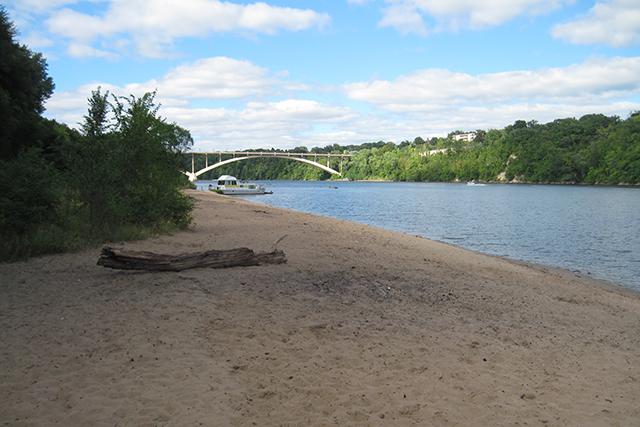
Everyone loves a lake beach. Spending an afternoon lazing around Calhoun or Hidden Beach is one of the best parts of summer in Minneapolis. To a person who grew up on a coast, it can be hard to appreciate the scale of lake beaches, which lack the one defining characteristic that make beaches on the ocean so appealing – the endless horizon line, the water stretching off into infinity. But it’s their modest size that makes city lake beaches so charming. Unlike the ocean, you can be 10 yards from a lake beach and not even know it’s there, until the moment you walk onto it. And then there you are, surrounded by a rollicking mass of humanity, making use of the very finite space: kids running around, sunbathers, recreational joggers, cyclists in spandex making the Grand Rounds, recreational fishers, and other types of lake beach people. Most everyone in Minneapolis is a lake beach person.
Not everyone in Minneapolis is a river beach person, though. River beaches are an oddball country cousin to the lake beaches. They’re a little scrappier, a little less recreational, a little more hard-edged. For one, no one’s swimming. Almost everything about the Mississippi is too dangerous for swimming – if the currents don’t get you, the mercury and polychlorinated biphenyl will. The waterways along the stretch of the Mississippi River between St. Anthony Falls and the Ford Dam are generally considered “impaired.” It’s pretty common to see people recreationally fishing in the river, but it’s rare to see anyone splashing around.

In fact, it’s rare to see many people at all on river beaches. Most of them have charred piles of driftwood from nighttime bonfires, but for the most part, they’re pretty empty. The city is full of places that are so bucolic you forget you’re in a city, but even by the standards of Minneapolis, the riverbanks are quiet. The gorge along West River Parkway is steep, and it’s not as easily accessible as the lakes. You have to walk down a flight of rustic stairways, built by WPA work crews in the 1930s, and then through some trails, under branches and over logs, before arriving on the beach. It’s a little bit of a trek getting there. You have to work for it.
There are a few beaches along the Mississippi between downtown and the Ford Dam. They were created when the Army Corps of Engineers dredged the river in the early 20th century, and sand was deposited as an afterthought on the banks. Though part of the Minneapolis Parks System, they’re not developed, noted on maps, or even marked or named. Their use seems to be accepted but not necessarily encouraged. They get whatever names people come up for them.
On the east side of the river near Franklin is a stretch known as Bare Ass Beach, a longtime spot for gay cruising, and notable for being the site of the murder of former state legislator John Chenoweth in 1991 at the hands of an anti-gay fanatic. On the west side, between Franklin and Lake, is a perfectly white-sanded beach, highly visible on Google Maps – from above, it looks like a streak of white paint on the riverbanks. A few of my friends who grew up in South Minneapolis tell me this beach has historically been known as White Sands.
On Labor Day, it’s very quiet, except for a man fishing while his two sons scurry up and down the dunes. It’s a surprisingly steep incline, and I can’t get over how white and gleaming the sand looks in the daylight. The scale of the Mississippi River is so different from that of an ocean or a lake. It’s not far across to the other side – you can see people hanging out on the rocky embankments near the St. Paul-Minneapolis border across the way very clearly – but the length of the river in either direction, and the idea of its central place in American mythology, is powerful and consuming enough to compel you to plop down on the white sand and think about it for a few minutes. The Mississippi is as important to the mythology of the United States as anywhere, and this is a front row seat to watch it go by.

A few blocks downriver, near 34th Street, across from St. Paul’s Shadow Falls Park, the river beach is comparatively bustling. I don’t know the beach’s name, and no one I ask seems to know of one, either. A large extended Hispanic family is having a barbecue – a half-dozen fishing poles are stuck in the sand, and when I ask how the fishing has been, the family patriarch produces three crappies they’ve just caught, all strung together. The kids are running around, offering me candy and drinking juice. It’s practically like being on a lake.

The boat traffic reminds you that you’re not on a lake, though. I don’t see any barges, but pleasure crafts of all kinds zip by, leaving wakes that lap up against the shore like the tides. Two young men in a canoe row ashore, and one of them scoops up the boat over his head and portages it across the beach while his friend walks behind him (“I got it last time,” he explained). On the other end of the beach, someone has docked a houseboat for what looks like a pretty prolonged period of time. I ask every person walking a dog that goes by from the direction of the houseboat if it’s theirs. No one claims it, although a woman walking by with her family asks me the same question (I am secretly flattered to be thought of as a potential houseboat owner). She’s brought her daughter-in-law to see the trails and beach from College Station, Texas – “they’ve got nothing like this down there,” she says.

These beaches are a consequence first of dredging and preparing the river for commercial use, and then of those remnants being preserved as part of a larger park system. They seem caught between two conflicting ideas the city’s always had about the river that runs through it. On the strictly pragmatic side, the Mississippi is the engine that’s driven the city’s economy from its founding, a passageway for sending lumber and flour downriver, the site of industry, harbors, and low-income immigrant settlements, and (for at least several decades prior to the 1930s) the city’s sewer. Near White Sands was the city’s first lock and dam, at Meeker Island, the remains of which are still visible when the river is low.
On the more romantic side, however – and this is certainly what informed the decision to preserve the gorge as parklands – the river and the areas around it have been thought of as, in the words of Parks Board President William Folwell in 1898, when the land was being acquired, “eminently adapted by situation, contour and natural vegetation.” The area is described by its founders and the people that use it today in almost religious terms, as a sort of sanctuary.
The beaches exist between those two ideas. If Minneapolis were, say, three or four decades older, the riverbanks between the two downtowns that make up the gorge would probably have been flattened and gobbled up by industrial development during the 1850s and 1860s – perhaps it would look more like a canal, more like the Chicago River. But by the late 19th century, at the time the parks system was being solidified, the overarching civic goal was to improve and preserve, to keep the riverbanks in a pristine natural state. And so, a century later, these beaches still have an untouched quality to them that, while something very special, can seem a little inert, a little hands-off. Like walking through any part of the physical landscape that doesn’t have an official name – alleys, for example – they always vaguely feel like you shouldn’t be there. Maybe that’s what makes it such a great place to sit on a towel on a sunny afternoon, make some river friends, and look out at the Mississippi River flow by.





Bare ass beach
Back in the 60s, the area along the river just south of the Lake Street bridge on the Minneapolis side, was called “bare ass beach.” That’s where my naïve, teenaged future wife and her girlfriends went exploring one day and were first introduced to the nude male anatomy. Or so they say. Yup, they were just sunning themselves there on the sand, minding their own business and along came a couple of fellows sans swimwear.
I recall going down there with some Central high-school friends (boys and girls) for a bonfire and make-out session, but we never encountered any other people. But now according to the Google map, it appears that since they’ve re-built the bridge, all that’s been changed. I see no sandy area at all in that vicinity. Interesting.
This is a beautiful article, Andy! Thanks for pointing out these serene spots for us, and explaining the contexts of their existence in the middle of the city and the river.
Sorry I’m late
Those rustic stone stairs were not there when I was a kid, nor when my first dog was a puppy.
I think they were built around the early 2000s. I thought, “Now everybody’s going to come down here.” Didn’t happen.
Lots of coyotes came since then though, but up-river, not down the stairs.